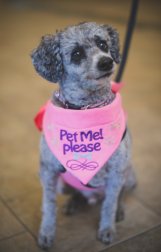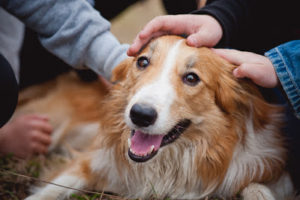
If you’d like to subscribe to the PuppyUp Foundation’s Newsletter (it’s free!), please email Ginger (ginger@puppyup.org) and ask to be added to our mailing list.
OCTOBER IS BREAST CANCER AWARENESS MONTH — BUT IT’S NOT JUST ABOUT PEOPLE

When we think of breast cancer, we usually think of people. But dogs (and cats) get breast cancer too. According to the ACVS (American College of Veterinary Surgeons) “more than a quarter of unspayed female dogs will develop a mammary tumor during their lifetime. The risk is much lower for spayed female dogs, male dogs, and cats of either gender. In female dogs, 50% of mammary tumors are benign and 50% are malignant. However, few of the malignant mammary tumors are fatal. In contrast, over 85% of mammary tumors in cats are malignant and most of these have an aggressive biologic behavior (i.e., mammary tumors in cats tend to be locally invasive and spread elsewhere in the body).”
Not all mammary tumors are cancerous. The most common benign form of canine mammary tumors is actually a mixture of several different types of cells. For a single tumor to possess more than one kind of cancerous cell is actually rare in many species. This combination cancer in the dog is called a ‘benign mixed mammary tumor’ and contains glandular and connective tissue. Other benign tumors include complex adenomas, fibroadenomas, duct papillomas, and simple adenomas.
However, there are multiple types of mammary cancers in dogs. All mammary tumors should be identified through a biopsy and histopathology (microscopic examination of the tissue) to help in developing the treatment plan for that particular type of cancer. The malignant mammary tumors include: tubular adenocarcinomas, papillary adenocarcinomas, papillary cystic adenocarcinomas, solid carcinomas, anaplastic carcinomas, osteosarcomas, fibrosarcomas, and malignant mixed tumors.
What are the symptoms of mammary cancer in dogs?
Mammary tumors are observed as a solid mass or as multiple swellings. When tumors do arise in the mammary tissue, they are usually easy to detect by gently palpating the mammary glands. When tumors first appear they will feel like small pieces of pea gravel just under the skin. They are very hard and are difficult to move around under the skin. They can grow rapidly in a short period of time, doubling their size every month or so.
It is very difficult to determine the type of tumor based on physical inspection. A biopsy or tumor removal and analysis are almost always needed to determine if the tumor is benign or malignant, and to identify what type it is. Tumors, which are more aggressive may metastasize and spread to the surrounding lymph nodes or to the lungs. A chest x-ray and physical inspection of the lymph nodes will often help in confirming this.
Mammary cancer spreads to the rest of the body through the release of individual cancer cells from the various tumors into the lymphatics. The lymphatic system includes special vessels and lymph nodes.
It is important to know that mammary cancer does not refer to a single disease but there are many different subtypes, each responding differently to treatment and each with a different prognosis.
Additional Helpful Information
Pet Education identifies these sub-classifications of mammary tumors is as follows:
Benign tumors
Adenoma
Simple adenoma
Complex adenoma
Basaloid adenoma
Fibroadenoma
Low-cellularity fibroadenoma
High-cellularity fibroadenoma
Benign mixed tumor
Duct papilloma
Malignant tumors
Non-infiltrating carcinoma
Complex carcinoma
Simple carcinoma
Tubulopapillary carcinoma
Solid carcinoma
Anaplastic carcinoma
Special types of carcinomas
Spindle cell carcinoma
Squamous cell carcinoma
Mucinous carcinoma
Lipid-rich carcinoma
To learn more about breast cancer in dogs, and treatment and surgical options, there are several helpful and detailed sites on the Internet you may consult:
The Bark http://thebark.com/content/breast-cancer-dogs
Mammary cancer in dogs: http://www.peteducation.com/article.cfm?c=2+2087&aid=460
Petwave: Symptoms of breast cancer in dogs: http://www.petwave.com/Dogs/Health/Breast-Cancer/Symptoms.aspx
Another article on symptoms can be found at VetInfo: https://www.vetinfo.com/dog-breast-cancer-symptoms.html
AVCS has helpful information, including photos, on mammary tumors here. Mammary tumors: https://www.acvs.org/small-animal/mammary-tumors
Pet Cancer Center is another good source, with detailed diagrams, prognosis, and outcomes. http://www.petcancercenter.org/Cancer_Types_Breast_Dogs.html
A BUSY FALL — UPCOMING PUPPYUP EVENTS IN OCTOBER AND NOVEMBER

PuppyUp Upcoming Walks and Other Events
(For general information and registration on any of these events, please visit our web site here.)
It’s going to be a busy fall around the country as the PuppyUp Foundation promotes numerous Walks and other PuppyUp events. We hope you’ll find an event to join in your area, and enjoy the company of friends and their dogs as they support the efforts of the Foundation in our shared fight against canine cancer.
In October
October 9 (Sunday) Puppy Up! Omaha from 11 AM to 3 PM At Chalco Hills Recreation Area at Wehrspann Lake, 8901 S. 154 Street, Omaha, NE. Info and registration here.
October 16 (Sunday) PuppyUp Denver – Painting N’ Sipping 05:00 PM – 07:00 PM Sipping N Painting, 6300 E. Hampden Ave, Denver, CO. For more information, click here.
October 21 (Friday) PuppyUp Houston @ Chick-fil-A 05:00 PM – 10:00 PM Chick-fil-A
Kuykendahl Rd, Houston, TX. To check out this event, follow this link.
October 22 (Saturday) Puppy Up! Wine Country Walk from 12 noon to 3 PM at Windsor Town Green, 701 McCllelland Drive, Windsor, CA. Info and registration here.
October 30 (Sunday) Puppy Up! Shoreline 11:00 AM – 03:00 PM Guilford Fairgrounds, Lovers Lane, Guilford, CT. Info and registration here.
October 30 (Sunday) Puppy Up! Atlanta 12:00 PM – 03:30 PM Brook Run Park, 4770 N. Peachtree Road, Dunwoody, GA. Info and registration here.
In November
November 5 (Saturday) Puppy Up! Denver 08:30 AM – 02:00 PM Stapleton Central Park, Denver, CO 80238 Info and registration here.
November 5 (Saturday) Puppy Up! Lake Norman 10:30 AM – 01:30 PM Daveste Vineyards,155 Lytton Farm Road Troutman, NC. Info and registration here.
November 5 (Saturday) Puppy Up! Little Rock 11:00 AM – 03:00 PM McArthur Park Pavilion, 601 East 9th Street, Little Rock, AR. Info and registration here.
November 6 (Sunday) Puppy Up! Huntington Beach, CA 08:00 AM – 12:00 noon Central Park, Goldenwest & Slater (behind Arco Station & Armstrong Garden Supply), Huntington Beach, CA Info and registration here.
November 13 (Sunday) Puppy Up! Hollywood, FL. 09:00 AM – 01:00 PM Ty Park, 3300 N. Park Road, Hollywood, FL. Info and registration here.
BAYLOR COLLEGE OF MEDICINE RESEARCHERS RECEIVE GRANT TO STUDY CANINE CANCER, TEST NEW THERAPIES FOR TRANSLATION TO HUMAN CANCERS

Dr. Jonathan Levitt of Baylor College of Medicine
(By Jeannette Jimenez, Houston, TX – Sep 29, 2016)
Researchers at Baylor College of Medicine have been awarded a $500,000 grant from the National Institutes of Health that will increase our understanding about the interactions between cancer and the immune system in dogs with naturally occurring tumors. The grant funds a collaboration between Baylor College of Medicine, Texas A&M College of Veterinary Medicine, the University of Florida College of Veterinary Medicine, Animal Medical Center of New York and Technical University of Denmark.
The project is led by Dr. Jonathan Levitt, associate professor of pathology & immunology at Baylor. Researchers will study dogs that have been diagnosed with cancer at the collaborating veterinary hospitals and apply that knowledge to the understanding of human cancer.
Having appropriate animal models for the study of human cancer is an important stepping-stone toward developing effective cancer immunotherapies and combination therapies, Levitt said. Immunotherapies are a type of cancer treatment that utilizes the body’s natural defenses to fight the cancer.
“The dog as model of human cancer offers a number of advantages for testing therapeutics,” said Levitt. “Dogs have a long lifespan, they are genetically diverse and we believe their immune systems may work similarly to that of people.”
The researchers will determine whether spontaneously arising canine organ-site tumors are sufficiently similar to those of humans to employ canine cancer as a model for trials of experimental combination therapies for human use.
“If it works out, this will be a win/win opportunity for both human and veterinary medicine. We can gain valuable insights into novel human cancer therapeutics while providing life-saving cancer treatment for pet dogs for whom successful cancer therapies may not exist,” said Levitt. “We will sequence mutations in canine cancers from bladder, breast and skin and compare them to those already studied in human tumors. This will allow us to ascertain whether these mutations can trigger immune responses in the dogs similar to those in people.”
Another major goal of this study is to characterize the immune cells that infiltrate canine tumors and compare them with those in the respective human cancers. Knowing the type of cells that infiltrate tumors is important because it may help predict the susceptibility of each tumor to specific therapies.
This study involves a large group of investigators, including Drs. John Rodgers, Alan Herron and William Decker in the Department of Pathology and Immunology, and Drs. David Wheeler and Linghua Wang in the Human Genome Sequencing Center at Baylor. Outside of Baylor College of Medicine collaborators include Dr. Rowan Milner at the University of Florida College of Veterinary Medicine, Dr. Heather Wilson-Robles at the Texas A&M College of Veterinary Medicine, Dr. Philip Fox at the Animal Medical Center of New York, and Dr. Morten Nielsen at the Technical University of Denmark in Copenhagen.
Read the article here.
PUP OF THE MONTH — PIERRE

Pierre on the job at the airport.
(Dana Schreiber) This is Pierre. He is a 13 year old miniature poodle. Three years ago during a routine dental cleaning, the anesthesiologist detected a lump that turned out to be thyroid cancer. Two weeks after the find, he had his thyroid removed (Dogs have two thyroid glands, one on each side of neck.) They removed the one with the lump in it, with no follow-up chemo or anything.
Three years later he is cancer free. And now he is the airport pet therapy dog at our local airport. I started the program here with Pierre a year ago May and this photo is from the airport’s press release. We visit once or twice a week and de-stress, calm and entertain passengers — mostly people who miss their dogs. Pierre is a certified Pet Partners member and has been doing other therapies, reading with kids and visiting nursing homes and teaching dog bite prevention classes since he was two.
(To learn more about thyroid cancer in dogs, check out this link.)
ANY TIME IS A GOOD TIME TO CHECK FOR LUMPS AND BUMPS

All hands on to check for lumps and bumps!
We all know the 10 warning signs of cancer in animals, but do you remember, while you’re hugging your pup, to feel for lumps and bumps? It’s all hands on, so get each family member involved. We all love to pet our favorite canines. Make sure everyone knows what to look for.
The 10 Early Warning Signs
1. Lumps Not all lumps and bumps are cancerous in dogs. There are sebaceous cysts, lipomas, and warts all of which are benign, but if you detect a growth on your dog it’s important to have it checked out by a veterinarian and if warranted, aspirated and biopsied.
2. Lesions Scratches and Abscesses are not uncommon for the normal, active dog but the sores that don’t heal can be of concern.
3. Lameness Bone cancer is typically found in larger breed dogs like Great Danes, Bernese Mountain dogs, Rottweilers, Boxers, Newfoundlands, Saint Bernards, and Great Pyrenees and the primary early indication is prolonged limping or favoring a limb or side. Other types of cancers can also cause persistent lameness.
4. Loss of Appetite If your dog shows no interest in eating or their daily consumption has declined for several days, take them to a vet.
5. Lethargy Tiring out easily, unwillingness to exercise and loss of interest in normal daily activities can be an early sign of cancer.
6. Weight Loss Not to be confused with loss of appetite. Cachexia, or emaciation, is often associated with cancer and can occur even if your dog is still eating normally. So if your dog is inexplicably losing weight, consult a veterinarian.
7. Strong or Offensive Odor A very strong and offensive smell can sometimes be a byproduct of tumors in the mouth and nasal cavity.
8. Loss of Normal Body Functions Dogs having difficulty voiding or defecation or unusual urine or feces should be looked at.
9. Bleeding or Bloody Discharge Blood present in vomit, stool, and nasal discharge are cause for serious concern and, although not always telltale signs of cancer, your dog should be examined as soon as possible.
10. Labored Breathing Abnormal respiration or respiratory distress can be a symptom of cancers in dogs.
ADDITIONAL WAYS TO HELP



Shop our PuppyUp Store! You can find all sorts of neat gear here.
You can find just about anything on Amazon.com. When you shop there, please help The PuppyUp Foundation. If you follow this link every time you shop on Amazon, they will donate a percentage of your order to 2 Million Dogs/The PuppyUp Foundation. Thank you.
DISCLAIMER
The PuppyUp Foundation does not endorse nor recommend any particular product, service, or treatment. We offer information strictly for educational and/or informational purposes. We believe it is the pet owner’s responsibility to do the research and draw his or her own conclusions.
We can always use your help. If you’re interested, send Ginger Morgan an mail at ginger@puppyup.org.








